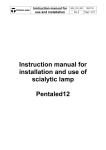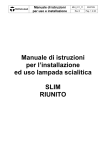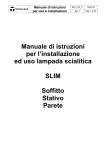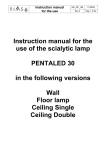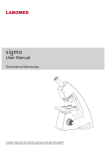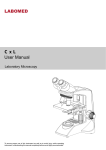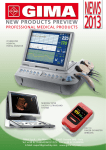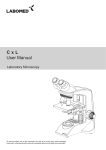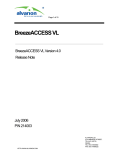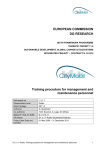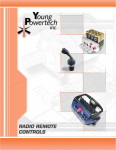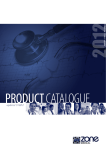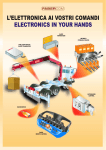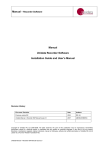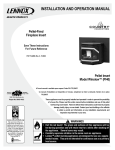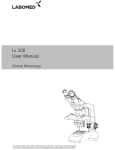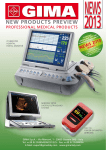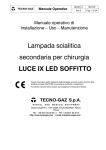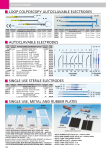Download Rimsa PentaLED 12 User Manual & Installation Guide
Transcript
Installation and operator’s manual MIU_010_GB 14/02/12 Rev.4 Page 1 of 34 Installation and operator’s manual for surgical light system Pentaled12 Installation and operator’s manual MIU_010_GB 14/02/12 Rev.4 Page 2 of 34 Introduction Dear user, You are kindly invited to read this manual carefully before proceeding to use the Product in order to safeguard yourself and other people from any injuries. Mark This appliance is a Class 1 medical device pursuant to European Directives on medical devices (MDD) 93/42/EEC, Annex IX, and 2007/47/EC. Conformity The manufacturer declares that this product is in compliance with Annex I (essential requirements of Directive 93/42/EEC and certifies such conformity by affixing the CE mark. The Product is classified in risk group 1 according to IEC 62471 standard (Photobiological Safety of Lamps). Validity of manual This operator’s manual refers to the following products: • Customer service Pentaled12 The customer service is at your disposal in case of Product details, information concerning its use, identification of spare parts being required and for any other queries you might have concerning the appliance, for ordering spares and for matters relating to assistance and warranty. Copyright • RIMSA P.LONGONI SRL • Via Monterosa 18 • I-20831 Seregno MB • Tel.: ++39 0362 325.709 • Fax: ++39 0362 328.559 • Email: [email protected] The contents of this Manual may be amended by Rimsa, without prior notice or any further obligations, in order to make changes and improvements. The reproduction, including partial, or translation of any part of this manual is forbidden without the written permission of RIMSA. Installation and operator’s manual MIU_010_GB 14/02/12 Rev.4 Page 3 of 34 Right to make changes Rimsa reserves the right to change, cancel or otherwise amend the data contained in this document at any time and for any reason without prior notice inasmuch as Rimsa is constantly seeking new solutions which lead to product evolution. Rimsa therefore reserves the right to make changes to the supplied Product in terms of shape, fittings, technology and performances. Translations With regard to translations into languages other than Italian, reference shall always be made to the Italian edition of this operator’s manual. Installation and operator’s manual MIU_010_GB 14/02/12 Rev.4 Page 4 of 34 Declaration of Conformity of the Manufacturer The company: RIMSA P. LONGONI S.r.l. Via Monterosa, 18/20/22 - 20831 SEREGNO (MB) - ITALY Declares under its own responsibility that the Product (Medical lighting device for surgical and diagnosis use): PENTALED 12 APPLICARE ETICHETTA made by RIMSA P.LONGONI S.r.l., complies with Annex VII of Directive 93/42/EEC dated 14/05/1993, and subsequent amendments (including Directive 2007/47/EC dated 05/09/2007) and the following standards: • • • IEC 60601-1 IEC 60601-2-41 IEC 60601-1-2 (Part 1: General requirements for basic safety) (Part 2: Particular requirements for the basic safety) (Part 1: General requirements for basic safety – EMC) Classification with reference to article 9 and Annex IX of Directives 93/42/EEC and 2007/47/EC DURATION: Short term (Par.1 “Definitions”, art.1, sub-section 1.1, annex IX) DESCRIPTION: Non-invasive medical device (Par.1 “Definitions”, art.1, sub-section 1.2, annex IX) Active medical device (Par.1 “Definitions”, art.1, sub-section 1.4, annex IX)IX) CLASS: • • • I (Par.3 “Classification”, art.1, sub-section 1.1 Rule 1, annex IX) Reference to technical file Code RIM-FT019. The conformity assessment is developed with reference to article 11 of Directive 93/42/EEC and 2007/47/EC. The RIMSA Quality System complies with UNI EN ISO 9001 and UNI CEI EN ISO 13485 standards and is certified by CSQ (CSQ certificate no. 9120.RMS1 and 9124.RMS2). Name: Paolo Longoni Position: Managing Director Installation and operator’s manual MIU_010_GB 14/02/12 Rev.4 Page 5 of 34 Table of Contents 1 General information................................................... 8 1.1 Qualification of operators ........................................ 9 1.2 Packaging, transport, storage and characteristics of the installation site .......................................................... 9 1.3 Graphic symbols used in the installation manual 10 1.4 Graphic symbols used on the package ................ 11 1.5 Other graphic symbols used on the Product ....... 11 1.6 Warranty Certificate ................................................ 12 2 Precautions for the appliance operator ................. 13 2.1 Technical safety specifications ............................. 13 2.2 Personnel training obligation ................................ 13 2.3 Warranty and liabilities .......................................... 14 2.4 Structural changes or variations ........................... 14 2.5 Disposal after use ................................................... 14 3 Mechanical and electrical arrangement of the site14 3.1 Mechanical arrangement of the site...................... 15 3.2 Electrical arrangement of the site ........................ 17 4 Product installation ................................................... 18 4.1 Ceiling Product installation .................................... 18 Installation and operator’s manual MIU_010_GB 14/02/12 Rev.4 Page 6 of 34 4.1.1 Installation of ceiling plate, anchoring tube, power supply and covering ..................................................... 18 4.1.2 Installation of the structure on the ceiling tube19 4.2 Mobile version Product installation ...................... 19 4.2.1 Installation of stand, power supply and covering 19 4.2.2 Installation of the heeling arm and head .......... 20 4.3 Wall version Product installation ........................... 20 4.3.1 Installation of wall plate and power supply ..... 20 4.3.2 Structure installation.......................................... 20 4.4 Ceiling double version Product installation .......... 21 4.4.1 Installation of ceiling plate, anchoring tube, power supply and covering ..................................................... 21 4.4.2 Installation of structure to the suspension tube22 4.5 Connecting to electrical plant ............................... 22 4.6 First starting ............................................................ 23 4.7 Installation verification and Products testing operations before use................................................... 23 5 Importance of personal safety ................................ 24 5.1 Intended use ........................................................... 24 5.2 Environmental conditions ..................................... 25 5.3 Technical safety conditions .................................. 25 Installation and operator’s manual MIU_010_GB 14/02/12 Rev.4 Page 7 of 34 5.4 Other safety conditions (secondary effects) ........ 26 6.1 Product description ............................................... 26 6.2 Description of the operation .................................. 27 7 Cleaning and disinfection ....................................... 28 7.1 Cleaning the Product.............................................. 28 7.2 Disinfecting ............................................................. 28 7.3 Sterilizing the handpieces ..................................... 29 7.4 Yearly inspections by the operator ....................... 30 8 Adjustments ............................................................. 30 8.1 Adjustment of the swing arm ................................ 30 8.2 Adjustment of the braking force............................ 31 8.3 Troubleshooting...................................................... 31 8.4 Routine maintenance ............................................. 32 8.5 Spare part list .......................................................... 32 9 Technical data............................................................. 33 Notes .............................................................................. 34 Installation and operator’s manual MIU_010_GB 14/02/12 Rev.4 Page 8 of 34 1 General information IMPORTANT Product The ME (Medical-Electrical) EQUIPMENT to which this manual refers is a LAMP for Operating Theatre or SYSTEM of LAMPS for Operating Theatre of the PENTALED series and D series. For easier description such ME EQUIPMENT will be indicated in this manual with the name of “Product”. CAUTION This manual is an integral part of the Product as required by European directive 93/42/EEC and 2007/47/EC. Always keep this installation manual close to the lamp. CAUTION - The Product is not suitable for use in explosion-risk areas - The Product is not suitable for use in the presence of inflammable mixtures of anaesthetics with air, oxygen or NO2 (laughing gas) CAUTION RIMSA disclaims all liability for any injuries to persons or damage to things caused by the installation, maintenance or use of the Product by unqualified operators. By qualified operator is meant whosoever has attended a course relating to the installation, maintenance and use of the product organised by RIMSA or, alternatively, whosoever has carefully read this installation manual. CAUTION The only party responsible for Product installation is the buyer’s customer itself; no cost or responsibility relating to installation and/or commissioning of the Product shall therefore be traced back and/or in any case attributed to RIMSA. CAUTION The masonry works involving the preparation of the ceiling or wall, for Products to be installed on the ceiling or wall respectively, and the electric works for preparing the power supply system for the Product shall be of a sturdy and safe nature and completed in a workmanlike manner by suitably trained personnel. By way of example only, without limitation, the following professional figures are deemed adequately trained: Ö Building Engineer, Draughtsman, Building firm duly registered in the professional Register (for masonry works) Ö Electro-technician qualified to exercise the profession of electrician (for the electrical works) Installation and operator’s manual CAUTION MIU_010_GB 14/02/12 Rev.4 Page 9 of 34 Electrical installation must be made in compliance with the IEC 60364-7710 standard and any national regulations and must contemplate protection with fuses or thermal magnetic disconnection switch and the fitting of a master switch able to ensure the complete interruption of the power supply to the Product. CAUTION The Product is a ME EQUIPMENT and consequently falls within the field of application of the EN:62353 standard. Consequently, any operation performed on the Product must be carried out in compliance with the EN:62353 standard, where applicable. 1.1 Operator qualification Qualification of operators This paragraph describes the requirements and qualifications which the operators involved in the various stages of Product life and use must possess. Installation the Product must be installed by a qualified Installer and/or Technician Use Professional medical personnel Routine maintenance Qualified technician in possession of professional technical requirements Special maintenance Qualified technician in possession of professional technical requirements Assistance Dealer who has attended a technical course on the Product organised by the manufacturer Cleaning Properly trained medical and paramedical personnel Demolition at the end of the Product life cycle, dispose of the used Product in an environment-friendly way and in compliance with the national directives applicable to waste disposal. 1.2 Packaging, transport, storage and characteristics of the installation site Packaging Boxes containing the whole structure, with installation manual and user manual. Transport Transport is carried out by any road haulage contractor as long as they respect the following characteristics: Temperature (°C): -15 / +60 Installation and operator’s manual MIU_010_GB 14/02/12 Rev.4 Page 10 of 34 Humidity: 10 / 75 % Atmospheric pressure (h/Pa): 500 / 1060 Storage The devices packaged must be stored (warehoused) in a dry place and at the following temperature: Temperature (°C): -15 / +60 Humidity: 10 / 75 % Atmospheric pressure (h/Pa): 500 / 1060 Installation site The site appointed for the installation of the equipment must have the following characteristics: Temperature (°C): +10 / +40 Humidity: 30 / 75 % Atmospheric pressure (h/Pa): 700 / 1060 1.3 Graphic symbols used in the installation manual In this installation manual and on the Product important directions are marked by means of symbols and identifying words. Identifying words such as DANGER, WARNING or CAUTION indicate the classification of the risk of damage. DANGER signals an immediately dangerous situation which might cause death or serious damage. WARNING signals a potentially dangerous situation which might cause death or serious damage. CAUTION signals a potentially dangerous situation which might cause moderate or slight damage. The following triangular symbol coupled with a side explanation indicates which danger is being faced: Electric shock, Mechanical danger due to hanging masses (quick release of a suspension arm) Installation and operator’s manual MIU_010_GB 14/02/12 Rev.4 Page 11 of 34 1.4 Graphic symbols used on the package The symbols present on the boxes of the packages are listed below: High side of the package Maximum number of packages stackable Breakable package Humidity-suffering package Do not overlap packages with pallet Weight of the package 1.5 Other graphic symbols used on the Product The symbols present on the Product are listed below: B-Type device. Indicates the level of protection against direct and indirect contact Graphic symbol proving the CE marking of the product Symbol indicating the manufacture date (month and year) Fuses used by the device Installation and operator’s manual MIU_010_GB 14/02/12 Rev.4 Page 12 of 34 1.6 Warranty Certificate 1. The appliance is covered by an 18-month warranty, including electrical parts. 2. The warranty begins on the date of Product shipment from the RIMSA warehouse to the buyer. 3. In case of disputes, the date indicated on the “transport document” attached to the goods shall be deemed valid. 4. The warranty only covers the sending of Product spare parts to the buyer or, in the event of RIMSA considering the replacement of spare parts not feasible, the replacement of the entire Product, after fabrication faults have been properly ascertained at the undisputable judgement of RIMSA. The warranty does not therefore cover any other costs or expenses (including, by way of example but without limitation, labour costs, packaging costs and transport costs, etc.). 5. The guarantee does not include the components subject to normal wear, such as halogen bulbs, LEDs, fuses, relays, ball bearings, etc. 6. The warranty does not cover: - malfunctions due to failure to comply with the instruction manuals; - malfunctions due to installation and/or maintenance errors; - malfunctions or faults caused by carelessness, negligence, incorrect use or other causes not attributable to RIMSA; - malfunctions or faults due to the fact that the electrical system of the premises where the machine is installed is not in compliance with International or local standards for electrical systems in premises used for medical purposes and similar standards. 7. RIMSA shall repay direct damages suffered by the buyer and which are documented as attributable to its Product, caused within the warranty period, for an amount not above 40% of the net value of the product as indicated on the buyer’s invoice. RIMSA’s liability is expressly ruled out for indirect damages or consequential damages (including cases of the lamp not being used) deriving from the supply. 8. This warranty certificate replaces legal warranties for faults and non-conformities and rules out any other possible liability of RIMSA originating from the supplied Products. 9. The payment of any damages to persons or things due to Product malfunction or faults shall be limited to the maximum amount of RIMSA’s insurance coverage for civil liability. 10. The warranty shall be automatically invalidated in the event of: - the Product having been tampered with or modified by the buyer or third parties; Installation and operator’s manual MIU_010_GB 14/02/12 Rev.4 Page 13 of 34 - the Product having been repaired by the buyer or third parties, without following the instructions in the instruction manuals; - the Product serial number having been cancelled, defaced or removed; - the buyer not being up to date with payments. 11. For jobs to be done under warranty, the buyer shall contact RIMSA only. 12. The component parts replaced under warranty must only be returned to RIMSA, if so requested by RIMSA, carriage free and suitably packed. 13. In case of failure to return a part requested by RIMSA, the cost of the component part will be charged. 14. RIMSA cannot accept returns from end users or in any case from parties other than the buyer. 15. Products returned to RIMSA must be complete with documentation authorising such return and another document describing the malfunction. 16. For everything not indicated on this warranty certificate, reference shall be made to the laws of Italy. 17. For all disputes deriving from or related to the orders to which this warranty certificate applies and which cannot be amicably settled between the parties, the only competent law court shall be that of Milan. 2 Precautions for the appliance operator 2.1 Cleaning personnel Technical safety specifications The Product cleaning and disinfecting operations described in Chapter 7 must only be performed by duly trained personnel. Servicing personnel The inspection and maintenance operations described in Chapter 8 must only be performed by professional technical personnel. 2.2 Instructing users Personnel training obligation Instruct personnel according to the operating instructions as regards controlling, cleaning and looking after the lamp. The operator must provide such personnel with written instructions based on this manual. Installation and operator’s manual MIU_010_GB 14/02/12 Rev.4 Page 14 of 34 2.3 Warranty and liabilities Rimsa disclaims all liability as regards unreliable Product operation in the following cases: - assembly, changes and repairs not being made by a technician who has attended a training course on the Product organised by the manufacturer or by a professional technician, - the Product not being used for the purposes for which it was intended, in compliance with the operating rules and instructions. 2.4 Arbitrary changes Structural changes or variations For safety reasons, no arbitrary structural changes or variations to the Product are acceptable. In case of changes or transformations of this kind, the manufacturer’s Product warranty shall be invalidated. The manufacturer thus disclaims all liability for any damage or injuries caused by any arbitrary structural modifications or variations made or the use of non-original spare parts. Only use original The use of parts not supplied by Rimsa or its dealers shall invalidate the Rimsa spare parts warranty. 2.5 Disposal after use Disposal at the end The used Product contains valuable materials which can be recycled. of life cycle Dispose of the used Product in an environment-friendly way and in compliance with applicable national directives on waste disposal. 3 Mechanical and electrical arrangement of the site NOTE The building and electrical arrangement works for the installation of the Product are the responsibility of the Final Customer. Installation and operator’s manual MIU_010_GB 14/02/12 Rev.4 Page 15 of 34 3.1 DANGER Mechanical arrangement of the site The building slab arrangement works to install the Product must be carried out in a solid and safe way according to the standards by qualified personnel. By qualified personnel we mean, including but not limited to, the following professionals: Building Engineer, Surveyor, Building Contractor, duly registered with the Professional Register. DANGER In case of improper drilling, e.g. drilling of a piece of iron of the reinforced concrete, the technician responsible for the construction will have to be informed for safety reasons, since the statics of the premises might be compromised. CAUTION The ceiling must have a capacity of at least 300 Kg/m2 and a thickness of at least 250 mm. The installation site must be declared fit for use. After making sure that the site used as medical premises complies with the requisites required above, proceed to the mechanical anchorage of the ceiling plate determining the type of ceiling for the anchorage and acting accordingly. The installer assumes all responsibility, technical, civil and legal, related to the correct and suitable arrangement of the anchorage and installation of the Product, which must be carried out according to the standards. Fixing positions The Product is supplied complete with ceiling attachment (tiges + counter plate)/ wall attachment (wall plate). Tiges length varies in relation to the height of the premises in which the Product is to be installed. The anchoring tube is calculated to install the Product at a finished height from the floor to the cupola of the Product with the oscillating arm in a horizontal position of about 190/200 cm, save a different request from the client. As a non-exhaustive example, we list some of the types of slab: Reinforced concrete Mechanical anchorage: fix the ceiling plate by means of 6 screw anchors Hilti HSL-3-G M8/20 following the directions given by the insert manufacturer scrupulously and listed below for information: Installation and operator’s manual MIU_010_GB 14/02/12 Rev.4 Page 16 of 34 Anchor tie-rod HSL-3-G M8/20 do (mm) t (mm) hs (mm) l (mm) Mt (Nm) SW (mm) x (mm) 12 80 60 98 25 13 20 do Nominal diameter of the point Mt t Minimum depth of drilling Sw Opening of the spanner hs Minimum depth of insertion l Length of anchor tie-rods x Closing torsion moment Fixing height 1. Using the paper template attached to this manual, mark all the 8/6 fixing holes of the chosen point of the ceiling/wall. 2. Make the first hole according to the safety anchor diameter. 3. By means of a pump or vacuum cleaner with pipe terminal, remove the dust and the small drilling fragments from the hole. Installation and operator’s manual MIU_010_GB 14/02/12 Rev.4 Page 17 of 34 4. The anchor tie-rod must be inserted into the hole keeping it to axis and using a hammer. Attention! Consider the insertion depth. 5. By the hexagonal dynamometrical spanner tighten with spanner adjusted at the value specified by the constructor of the anchors, opening the anchor. The anchor tie-rod will immediately take the weight. 6. Make the remaining 7/5 holes and insert the anchor tie-rods as in previous points 2– 5. 7. After one hour, tighten the anchor tie-rods again with the tightening torque prescribed. Chemical anchorage: fix the tiges with n° 8/6 chemical injection anchors mod. Hilti HIT-HY 150 with HAS following the directions given by the manufacturer Hilti scrupulously. After arranging the chemical anchors to the CEILING/WALL, fix the tiges with nuts and lock nuts for each tie-rod and tightening with the hexagonal dynamometrical spanner you will tighten with spanner adjusted at the value specified by the constructor of the anchors. Clay-cement mix In this case it is compulsory to enclose the slab sandwich-like by the Product plate and the counter-plate. Plate and counter-plate must be enclosed to each other with M8 steel threaded bars each, blocked at the upper and lower ends by respective washers, nuts and lock nuts. 3.2 Electrical arrangement of the site DANGER The electrical system arrangement works of the site used as medical premises to power the Product must be carried out in a safe way according to the standards by qualified personnel. By qualified personnel we mean, including but not limited to, the following professionals: Electro-technician licensed to practise as electrician Installation and operator’s manual DANGER MIU_010_GB 14/02/12 Rev.4 Page 18 of 34 Before installing the Product check the following conditions: the electrical system of the installation site must comply with the national laws and/or regulations in force for electrical systems in sites used as medical premises; the electrical system must be certified by an electrician licensed to issue the conformity certificate; the verification of the grounding circuit must be certified as required by the norms in force. 4 Product installation Before installing the Product, make sure that all the packages are present and in good condition, without any transport-related damage, and that the contents correspond to what is specified above. Claims will be considered only if the seller or the forwarder are informed immediately. Each claim must be in writing. Goods are always carried at the buyer’s risk. Keep the original package in case the lamp must be sent back. 4.1 Ceiling Product installation 4.1.1 Installation of ceiling plate, anchoring tube, power supply and covering ATTENTION Incorrect plate levelling may cause the horizontal arm of the Product to make an undesired spontaneous move, when passing from the nonbalance condition to the balance one. See drawing 52 Position the template sheet (drawing 51) (2) on the ceiling (1) fixing it with adhesive tape (3). Make the 8 holes following what is prescribed in paragraph 3.1 See drawing 53 After making the holes on the ceiling (1), fix the plate (2) to the ceiling by nuts and lock nuts (3). See drawing 54 Fix the anchoring tube (1) to the threaded pins of the ceiling plate (2) by nut and lock nut (3), ensuring the correct rod levelling by means of a spiritlevel (4). See drawing 55 The anchoring tube (1) is supplied with a standard size of 100cm. Using a jigsaw (2), cut the tube to the desired size in relation to the height of the Installation and operator’s manual MIU_010_GB 14/02/12 Rev.4 Page 19 of 34 room (cut the tube from the side (3) opposite to the one with the fixing holes (4) of the horizontal arm). To determine the correct length of the tube use the table given (the recommended height between floor and lamp head is 200cm). See drawing 56 Insert the anchoring tube (1) down to beat into the ceiling plate hub (2) (keeping the cut side upwards); to lock it, tighten screw (3), the serrated washer (5) and the nut (4), thus exerting a hub pressing action and allowing the tube tightness. See drawing 57 By a drill (1), make a 7mm diameter hole on the tube side near the nut M8 (2) welded on the plate hub; then insert and screw the M8 conical-pointed dowel supplied in the nut (3) until its conical point presses against the hole previously obtained in the anchoring tube. DANGER – Product falling danger See drawing 58 Make sure that the Product power supply cable (1) can reach the power supply board (2) of the Product without creating interferences with the anchoring tube. Then position the cover (3) and the relevant locking ring (4). 4.1.2 See drawing 59 Installation of the structure on the ceiling tube Insert the connection cables (7) along the anchoring tube making them out from the tiges plate so they can reach the connection terminals of the electrical panel. Align the horizontal arm pin (3) with the anchoring tube (4). Connect the connectors (1) and (2). Insert the pin into the tube fitting in the relevant fixing holes, and fix it screwing in the four screws (5) using a hexagonal wrench (6). 4.2 Mobile version Product installation 4.2.1 See drawing 60 Installation of stand, power supply and covering Remove the bolt (2) from the stand bottom (1). Installation and operator’s manual MIU_010_GB 14/02/12 Rev.4 Page 20 of 34 Mechanical connection Position the stand (1) on the base (5) fitting and inserting its pawl (6) into the plate seat (7), use the bolt previously unscrewed to join the stand to the base and tighten thoroughly. Insert the cover (3) from the stand top and the relevant connecting clip (4). WARNING – Instability and falling danger Failure to insert the detent into the appropriate seat present on the basement plate implies the risk of instability and the possible fall of the structure. 4.2.2 See drawing 61 Installation of the heeling arm and head Align the heeling arm pin (8) with the floor stand (1). After connecting the electric cable terminals (9) to (10) each other, insert the heeling arm pin into the stand fitting in the holes (11) with those of the stand (12) and screw in the two locking screws (13) by a screwdriver. 4.3 Wall version Product installation 4.3.1 ATTENTION Installation of wall plate and power supply Incorrect plate levelling may cause the horizontal arm of the lamp to make an undesired spontaneous move, when passing from the non-balance condition to the balance one. See drawing 66 Position the template sheet (drawing 11) (2) on the wall (1) fixing it with adhesive tape (3). Make the 6 holes following what is prescribed in paragraph 3.1 See drawing 67 After making the holes on the wall (1), following what is prescribed in paragraph 3.1, fix the plate (2) to the ceiling ensuring the correct plate levelling by means of a spirit-level (3). 4.3.2 See drawing 68 Structure installation Align the horizontal arm pin (1) with the anchoring tube (2). Connect the connectors (3) and (4). Installation and operator’s manual MIU_010_GB 14/02/12 Rev.4 Page 21 of 34 Insert the pin into the tube fitting in the relevant fixing holes, and fix it screwing in the four screws (5) using a hexagonal wrench (6). 4.4 Ceiling double version Product installation 4.4.1 Installation of ceiling plate, anchoring tube, power supply and covering ATTENTION Incorrect plate levelling may cause the horizontal arm of the Product to make an undesired spontaneous move, when passing from the nonbalance condition to the balance one. See drawing 52 Position the template sheet (drawing 51) (2) on the ceiling (1) fixing it with adhesive tape (3). Make the 8 holes following what is prescribed in paragraph 3.1 See drawing 53 After making the holes on the ceiling (1), fix the plate (2) to the ceiling by nuts and lock nuts (3). See drawing 69 Fix the anchoring tube (1) to the threaded pins of the ceiling plate (2) by nut and lock nut (3), ensuring the correct rod levelling by means of a spiritlevel (4). See drawing 70 The anchoring tube (1) is supplied with a standard size of 96 cm. Using a jigsaw (2), cut the tube to the desired size in relation to the height of the room (cut the tube from the side (3) opposite to the one with the fixing hubs (4) for the horizontal arm); you should not cut the pipe below a length of 30 cm in order to facilitate the subsequent installation operations To determine the correct length of the tube use the table given (the recommended height between floor and lamp head is 200cm). See drawing 71 Insert the cover (1) on the suspension tube (2) and then, insert the suspension tube down to beat into the ceiling plate hub; to lock it, tighten screw (3), the serrated washer (4) and the nut (5), thus exerting a hub pressing action and allowing the tube tightness. See drawing 72 By a drill (1), make a 7mm diameter hole on the tube side near the nut M8 (2) welded on the plate hub; then insert and screw the M8 conical-pointed dowel supplied in the nut (3) until its conical point presses against the hole previously obtained in the anchoring tube. Installation and operator’s manual MIU_010_GB 14/02/12 Rev.4 Page 22 of 34 4.4.2 See drawing 73 Installation of structure to the suspension tube Align the horizontal arm pin (1) with the anchoring tube (2). Connect the connectors (3) and (4). Insert the pin into the tube fitting in the relevant fixing holes, and fix it screwing in the four screws (5) using a hexagonal wrench (6). Repeat the same operations for the second horizontal arm. At the end of the installation close the openings of the support tube through supplied silicone caps (7). 4.5 Connecting to electrical plant DANGER – Danger of electric shock Before connecting, make sure that the electrical system line is NOT under tension. The Product power supply group (support sheet, feeder, terminal board) is firmly fixed to the plate of the anchoring tube, to the base or to the wall box in case of a ceiling, mobile or wall version device respectively. As regards the connection of the electrical system line (F,N) and the lamp cables (+,-,T) follow what is specified in the specific wiring diagram attached. Fuses The device fuse protection is ensured by installing, on the input line (F,N), two fuses type: 5x20 T.1A (for 230V~) or 5x20 T.2A (for 110V~) See drawing 62 As for floor versions it is necessary to connect wires by the electric panel of the device; to do it, lift the connecting ring (1) and the cover (2). Now connect the connectors (3) (4) and (5) (6). Then reinstall the cover and the connecting ring and fix the cover by a screwdriver (7) tightening the screw M4 (8) and gripping inside the threaded bush (9) present on the electric panel support. CAUTION – Irreparable damage to the Product In the case of ceiling versions, the fuse protection to the electric panel terminals must be inserted ONLY AFTER completing the mechanical and electrical assembly of the Product. Advance insertion may cause irreparable damage to the light source. If the product is not used for long periods, remove the fuses. Installation and operator’s manual MIU_010_GB 14/02/12 Rev.4 Page 23 of 34 4.6 First starting Before supplying the Product with voltage, remove the protection film from the mobile base cover. ATTENTION Now it is possible to power the Product to make sure it gives out light. To do so you must: 1 – close the system circuit by means of the head system switch (charged to the customer) 2 – press the green switch on the base cover (Mobile version) 3 – press the I/O keyboard 4.7 Installation verification and Products testing operations before use CAUTION The following notes are to be considered compulsory during verification of the installation, since they prove the correct verification of all the points set out. For such reason it is necessary to tick each point when it is treated. 1. Verify the suitability of the ceiling/wall on installation of the Product 2. By means of a spirit-level, make sure the anchoring tube or wall plate is perpendicular 3. Make sure the bolt is well tightened on the locking clip Installation and operator’s manual MIU_010_GB 14/02/12 Rev.4 Page 24 of 34 4. Check the hole and make sure the safety dowel is inserted on the anchoring tube 5. Make sure the 4 screws M4 supporting the horizontal arm (ceiling and wall version) are well tightened 6. Make sure the mobile stand pawl is properly inserted into the relevant base seat 7. Check the Product earthing and make sure the earthing terminals are well tightened 8. Make sure the movement mechanism works perfectly. Check the mechanical operation of the Product by directing and rotating it and make sure that all movements are frictioned so that the Product is stable in any position and does not lose its position 9. After turning on the Product, it must give out light from the cupola Seal and signature of the installer: ___________________________________________________________ 5 Importance of personal safety 5.1 Intended use Use in compliance with standards The Product is made to light up the area occupied by the patient undergoing surgery or observation and has been designed for use in operating theatres or medical surgeries. Field of work The Product correctly lights up the field of work from a distance of about 70 – 140 cm from the point of operation. Single lamp: Definition In compliance with the IEC60601-2-41 standard, a single lamp (PENTALED12) is a secondary scialytic lamp for surgery and can only be used in operations where the interruption of lighting does not cause risks for the patient. Installation and operator’s manual MIU_010_GB 14/02/12 Rev.4 Page 25 of 34 System of operating lamps: Definition In compliance with the IEC60601-2-41 standard, a system of lamps made up of several lamp units can be used to locally light up the patient’s body without any limitation. It is also suitable for continuous function. It enables the surgeon to operate also in the most difficult conditions of visibility. It is intended to make treatment and diagnosis possible and to be used in operating theatres. Undesired effects If the light fields of several lamp units are superimposed, there will be an caused by increase in heat in the patient area with consequent dehydration of tissues superimposition of and, above all in the case of prolonged operation and reduced blood light fields supply, considerable damage to tissues. If reduced blood supply or the start of tissue dehydration occurs, reduce the light intensity. 5.2 Environmental conditions - The Product is not suitable for use in explosion-risk areas. - The Product is not suitable for use in the presence of inflammable mixtures of anaesthetics with air, oxygen or NO2 (laughing gas). - During operation, the ambient temperature must be between 10°C and 40°C. - Relative humidity must be between 30% and 75%. - Atmospheric pressure must be between 700 and 1060hPa. 5.3 Technical safety conditions The safe use and proper operation of the Product is ensured if: Safe fastening The lamp is safely fastened to the ceiling/wall from a static viewpoint and a static stability test exists, Wiring systems The wiring systems of the premises involved are in compliance with applicable local regulations, Authorised personnel Changes to the Product or maintenance jobs are performed by personnel trained by Rimsa or by a professional technician Correct assembly The Product has been installed following currently valid installation and start up instructions and has been started up by a professional installer, With regard to assistance, repairs, structural changes and additional Original spares accessories, only original Rimsa spare parts are used. Installation and operator’s manual MIU_010_GB 14/02/12 Rev.4 Page 26 of 34 5.4 Other safety conditions (secondary effects) Optical safety - Do not direct the light source into the patient’s and/or operator’s eyes. - Obligation to adequately protect the patient’s eyes. Failure to follow such precautions could cause glare and potential damage to the retina. Incorrect use - Never place and/or hang anything on the Product. Unless this precaution is taken, positioning will not be reliable and the danger exists of such objects falling in the operating area. - Never hang on the Product with the body weight of a person. Unless this precaution is taken, mechanical parts of the Product could be damaged. Covering the heads - Never cover the head of the Product during operation. Failure to comply could prevent heat exchange with the environment and the Product could overheat. Knocks - Avoid knocking the rocker arms and Product head. A violent knock could damage the Product and pieces of paint could chip off and fall onto the operating field in the patient area. 6 Product description and operation 6.1 Product description Versions See drawing 63 The Product is available in different versions: - mobile - ceiling - wall - ceiling double MOBILE version: wheel base (1), stand (2), stand extension (3), heeling arm (4), lamp head (5), function control keyboard (6), sterilizable handle (7), power supply plug (8). See drawing 64 CEILING version: ceiling anchoring tube (1), ceiling cover (2), horizontal arm (3), heeling arm (4), lamp head (5), control keyboard (6), sterilizable handle (7). See drawing 74 WALL version: wall box (1), horizontal arm (2), heeling arm (3), lamp head (4), function control keyboard (5), sterilizable handle (6). See drawing 75 Installation and operator’s manual MIU_010_GB 14/02/12 Rev.4 Page 27 of 34 CEILING DOUBLE version: ceiling anchorage tube (1), tiges cover (2), horizontal arm (3), heeling arm (4), lamp head (5), function control keyboard (6), sterilizable handle (7). 6.2 Description of the operation Control panel The function control keyboard is applied to the Product cupola. Such keyboard allows to turn the lamp on and off by means of the membrane key I/O (1), to regulate the light intensity by pressing the keys with the symbols ‘+’ (2) and ‘-‘ (3), and display the level of intensity reached through 3 green position micro-LEDs (4). 1 4 2 Light field 3 The light field is fixed and therefore any adjustment of its diameter dimension is prevented. Installation and operator’s manual MIU_010_GB 14/02/12 Rev.4 Page 28 of 34 7 Cleaning and disinfecting 7.1 Cleaning the Product CAUTION – Electric shock hazard Switch the Product off by means of the operating theatre main switch and make sure it cannot be switched back on. Protect the Product against water spray and do not clean it/disinfect it with liquids. Leave the lamp body to cool down. Only clean the lamp body when it is cold. Clean with appropriate detergent with low alkaline content and chlorine free. IMPORTANT Do not use abrasive products, petrol, paint thinners, alkaline detergents, acids, containing alcohol or aldehydes; Dose the detergents so no liquids penetrate into the lamp bodies and into the support arm system. Clean the Product with a damp but not wet cloth. 7.2 Disinfecting CAUTION – Electric shock hazard Switch the Product off by means of the operating theatre main switch and make sure it cannot be switched back on. Protect the Product against water spray and do not clean it/disinfect it with liquids. Leave the lamp body to cool down. Only disinfect the lamp body when it is cold. CAUTION Disinfectants can contain substances which are harmful for the health: only use disinfectants in accordance with the rules on hygiene established by the hospital. Installation and operator’s manual MIU_010_GB 14/02/12 Rev.4 Page 29 of 34 The Product operator must comply with the rules established by the national commission for hygiene and disinfection. IMPORTANT To prevent damaging parts in stainless steel or aluminium, only use disinfectants which are chlorine and halogen free. To prevent the plastic parts becoming fragile, use only disinfectants with low alcohol content. Dose the disinfectants so no liquids penetrate inside the lamp bodies and into the support arm system. Clean the Product with a damp but not wet cloth. 7.3 Sterilizing the handpieces CAUTION – Hazard for the patient Replace the handpieces as soon as these become cracked or deformed, as these could fall in the wound area. The Product operator must comply with the rules of the national commission for hygiene and disinfection. Handpiece fitting / removal: - press the two lateral safety keys of the handle and extract the handle itself. - insert the handle till the bottom until the safety keys don’t fall in their seats. Cleaning, disinfecting and sterilizing the handpiece: The handpieces are made of plastic material resistant to heat and knocks (PPSU). They can be cleaned with a lightly-alkaline detergent free of active chlorine. To disinfect the handpieces, we suggest using alcohol or aldehyde-based products. The disinfectants must be approved by the manufacturer for use on polyphenylsulfone (PPSU). Before sterilizing, rinse the handpieces. The handpieces can withstand about 300 steam sterilization cycles as follows: or steam sterilization at 121°C 1.3bar from 25 to 30 minutes, Installation and operator’s manual MIU_010_GB 14/02/12 Rev.4 Page 30 of 34 - steam sterilization at 134°C 2.3 bar for 4 minutes. Position the handpieces straight with open side downwards. Do not exceed a sterilization temperature of 134°C. Avoid the handpieces coming into contact with other objects during the disinfection process. Each Product, over time, is subject to a certain amount of wear. Product safety and operation must therefore be checked during inspection and maintenance intervals. 7.4 Yearly inspections by the operator IMPORTANT Keep to the yearly inspection schedules and inspect the product according to IEC 62353 standard. 8 Adjustments 8.1 Adjustment of the swing arm See drawing 65 The Product is sold already balanced and does not require further adjustment. In the event of the swinging arm with spring balancing becoming stiff or loose over time, mechanical intervention is possible by regulating the compression of the internal spring. Slide the rubber grommet forward (1) and the cover (2) along the heeling arm (3). Insert a pin (4) having maximum diameter of 4mm into the holes of the ring nut (5) and rotate in the directions of the arrows to increase/decrease the charge of the spring. If the heeling arm lowers, the elastic force of the spring is insufficient: - rotate the lever downwards to charge the spring. If the heeling arm still goes up, the elastic force of the spring is too high: - rotate the lever upwards to discharge the spring. After making adjustments, return the covering to its original position. Installation and operator’s manual MIU_010_GB 14/02/12 Rev.4 Page 31 of 34 8.2 Adjustment of the braking force See drawing 65 As for all the mechanic parts, brakes also are subject to wear and tear. If the lamp body does not automatically keep the position it is put to, it is necessary to adjust the braking force by acting on the screws of the brakes. Horizontal arm brakes Use a 2.5 hexagonal wrench (7) to increase the braking force, rotating the arm brake dowels (6) clockwise. 8.3 Troubleshooting no. Problem 1 The Product does not remain in position 2 The Product fails to work 3 4 The fuse continues to burn out The light flickers and produces a stroboscopic effect 5 The light beam on the operating field is not focalised (defective meeting of light fields) 6 The Product does not switch on Solution Make sure the plate fitted on the wall (wall) is perfectly flat, that the stem is flat on the base (mobile) and that the tube secured to the ceiling (ceiling) is level. Further tighten the brakes on the joints so as to increase friction. Check the presence of the fuses inside the terminal box (T1A for 230V~ or T2A for 110V~), the hooking of the electrical connectors. Check the presence of voltage in the lamp head Check the characteristics of the fuses inserted T1A with 230VAC T2A with 100VAC Contact the service center Contact the service center. Check the power supply voltage and fuses. Electronics are damaged: contact the service center Installation and operator’s manual MIU_010_GB 14/02/12 Rev.4 Page 32 of 34 8.4 no. 1 2 Routine maintenance Job Period Inspect all the lamp joints and make sure they do not squeak. If they do, add white grease to the clutches involved. If the Product does not maintain the position, adjust the clutches. To determine which clutches to adjust, see point 6.2. Every 6 months Make sure the Tiges retention screws are tightened properly. Also check the 6 horizontal arm retention screws and the 3 swing arm screws. If these are not properly fastened, adequately tighten. Once a year Check the integrity of the leads from the PCB to the board and that these are fastened properly. If they are not, proceed to correctly tighten. INTERRUPT THE POWER SUPPLY BEFORE PERFORMING THESE OPERATIONS. 3 Once a year 4 Once a year Make sure the line voltage is correct. Make sure 24V are reaching the board. 5 Once a year Check the condition of the Product paint. Make sure there are no paint pieces that could fall on the operating field. 8.5 Spare part list Description Order code Sterilizable handle Z180045 Electronic card PENTALED 12 Z300617 Electronic card Z300220 Installation and operator’s manual MIU_010_GB 14/02/12 Rev.4 Page 33 of 34 9 Technical data Technical data on light Illumination Ec at a distance of 1 m [Lux] ±10% PENTALED 12 50.000 Color temperature [K] ±5% 5.000 K (±5%) Color rendering index Ra [-] 90 Diameter of the light field d50 [mm] 85 Diameter of the light field d10 [mm] 140 Illumination depth [mm] 1500 Maximum irradiation [W/m2] 119 Irradiation / Illumination [mW/m2lx] 2,38 Maximum irradiation in the UV [W/m2] 0,001 Focus by handle No Data on electrical connection Primary alternating voltage [Volt ac] Frequency [Hz] 100÷240 50/60 Absorbed power [VA] 40 Light source N°12 Led x 2W LED light source duration [h] (this datum can vary according to voltage peaks and the frequency of use) Light intensity control 50.000 50 - 100 General data Color RAL 9003 Directive 93/42/EEC (included 2007/47/EC) Standard EN 60601-2-41 Installation and operator’s manual MIU_010_GB 14/02/12 Rev.4 Page 34 of 34 Electrical safety class Class I Protection against direct and indirect contacts B-type device Dimensions Lamp body diameter [cm] 30 Diameter of the poly-elliptical reflector [cm] 5,5 Light emission surface [cm2] 285 Scialytic mobile, ceiling, wall, ceiling double lamp weight [Kg] 18; 13; 11; 20 Certificates Complying with directive 93/42/EEC (included 2007/47/EC) Notes n9 168 D 184 D C 368 C B 184 B A Disegno di dima per l'esecuzione dei 6 fori dis.11 (drawing to be used to do 6 holes, dwg n.11 Formato A3 (A3 format) A Drawing code 11 CEILING PLATE SHEET TEMPLATE DIMA PIASTRA A SOFFITTO (SCALE 1:1) 1 8 2 7 3 6 4 5 SHEET FORMAT: A3 Drawing code FORMATO FOGLIO: A3 Rev. Data 051 1 2 3 Drawing code Rev. Data 052 1 2 3 Drawing code Rev. Data 053 2 3 1 4 Drawing code Rev. Data 054 2 A A 1 B B Tube length list [mm] 1 Tabella lunghezze tubo [mm] 3 4 L 2000 H L H [mm] 2570 2600 2650 2700 2750 2800 2850 2900 2950 3000 3050 3100 3150 3200 3250 3300 3330 L [mm] 200 230 280 330 380 430 480 530 580 630 680 730 780 830 880 930 960 Drawing code Rev. Data A 23/04/2012 055 A 2 1 5 A 3 4 Drawing code Rev. Data 056 1 2 3 4 Drawing code Rev. Data 058 4 A 1 2 3 A 6 7 5 Drawing code Rev. Data 059 4 2 1 5 3 1 2 A 7 6 Drawing code A Rev. Data 061 8 11 13 9 A 10 1 12 A Drawing code Rev. Data 061 2 1 3 5 A 6 4 A 8 7 Drawing code 9 Rev. Data 062 4 3 5 2 8 1 6 7 Drawing code Rev. Data 063 3 2 1 5 4 A 7 A 6 Drawing code Rev. Data 064 6 7 2 1 6 7 A 3 5 A 4 Drawing code Rev. Data 065 4 1836 mm 2360mm 2 3 1 Drawing code Rev. Data A 23/04/2012 066 3 1 2 Drawing code Rev. Data 067 A 4 1 2 3 A B B 5 6 Drawing code Rev. Data 068 2 3 1 4 Drawing code Rev. Data 069 2 A A 1 B B Tube length list [mm] Tabella lunghezze tubo [mm] 1 3 4 L 2000 H L H [mm] 2700 2750 2800 2850 2900 2950 3000 3050 3100 3150 3200 3250 3300 3350 3400 L [mm] 300 350 400 450 500 550 600 650 700 750 800 850 900 950 1000 Drawing code Rev. Data 070 1 2 A 3 4 A 5 Drawing code Rev. Data 071 A 1 2 A 3 Drawing code Rev. Data 072 A 7 5 6 2 7 4 3 1 Drawing code A Rev. Data 073 4 A 2 6 3 1 A 5 Drawing code Rev. Data 074 2 3 1 3 4 A 7 5 4 7 A 5 6 Drawing code Rev. Data 075
































































